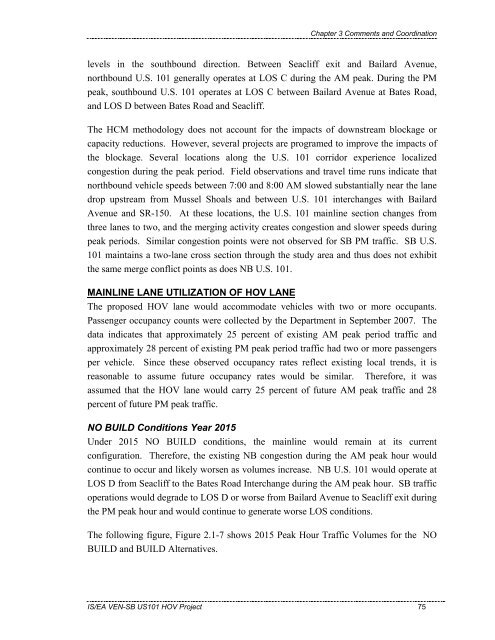Chapter 1 - Caltrans - State of California
Chapter 1 - Caltrans - State of California
Chapter 1 - Caltrans - State of California
Create successful ePaper yourself
Turn your PDF publications into a flip-book with our unique Google optimized e-Paper software.
<strong>Chapter</strong> 3 Comments and Coordination<br />
levels in the southbound direction. Between Seacliff exit and Bailard Avenue,<br />
northbound U.S. 101 generally operates at LOS C during the AM peak. During the PM<br />
peak, southbound U.S. 101 operates at LOS C between Bailard Avenue at Bates Road,<br />
and LOS D between Bates Road and Seacliff.<br />
The HCM methodology does not account for the impacts <strong>of</strong> downstream blockage or<br />
capacity reductions. However, several projects are programed to improve the impacts <strong>of</strong><br />
the blockage. Several locations along the U.S. 101 corridor experience localized<br />
congestion during the peak period. Field observations and travel time runs indicate that<br />
northbound vehicle speeds between 7:00 and 8:00 AM slowed substantially near the lane<br />
drop upstream from Mussel Shoals and between U.S. 101 interchanges with Bailard<br />
Avenue and SR-150. At these locations, the U.S. 101 mainline section changes from<br />
three lanes to two, and the merging activity creates congestion and slower speeds during<br />
peak periods. Similar congestion points were not observed for SB PM traffic. SB U.S.<br />
101 maintains a two-lane cross section through the study area and thus does not exhibit<br />
the same merge conflict points as does NB U.S. 101.<br />
MAINLINE LANE UTILIZATION OF HOV LANE<br />
The proposed HOV lane would accommodate vehicles with two or more occupants.<br />
Passenger occupancy counts were collected by the Department in September 2007. The<br />
data indicates that approximately 25 percent <strong>of</strong> existing AM peak period traffic and<br />
approximately 28 percent <strong>of</strong> existing PM peak period traffic had two or more passengers<br />
per vehicle. Since these observed occupancy rates reflect existing local trends, it is<br />
reasonable to assume future occupancy rates would be similar. Therefore, it was<br />
assumed that the HOV lane would carry 25 percent <strong>of</strong> future AM peak traffic and 28<br />
percent <strong>of</strong> future PM peak traffic.<br />
NO BUILD Conditions Year 2015<br />
Under 2015 NO BUILD conditions, the mainline would remain at its current<br />
configuration. Therefore, the existing NB congestion during the AM peak hour would<br />
continue to occur and likely worsen as volumes increase. NB U.S. 101 would operate at<br />
LOS D from Seacliff to the Bates Road Interchange during the AM peak hour. SB traffic<br />
operations would degrade to LOS D or worse from Bailard Avenue to Seacliff exit during<br />
the PM peak hour and would continue to generate worse LOS conditions.<br />
The following figure, Figure 2.1-7 shows 2015 Peak Hour Traffic Volumes for the NO<br />
BUILD and BUILD Alternatives.<br />
IS/EA VEN-SB US101 HOV Project 75

















